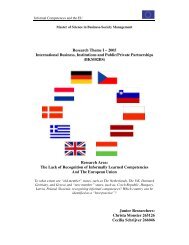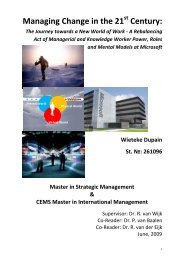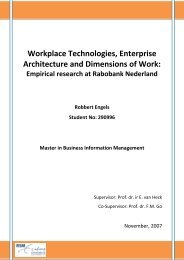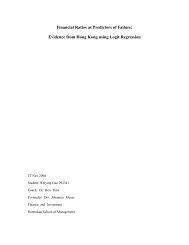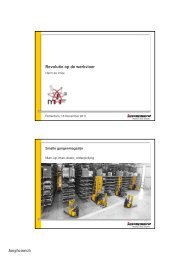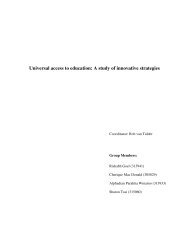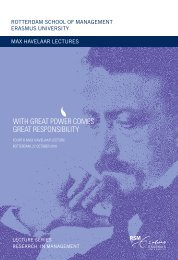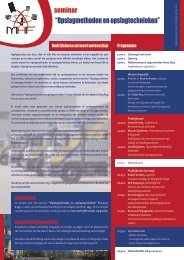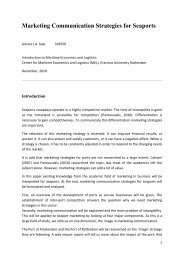here - ERIM - Erasmus Universiteit Rotterdam
here - ERIM - Erasmus Universiteit Rotterdam
here - ERIM - Erasmus Universiteit Rotterdam
You also want an ePaper? Increase the reach of your titles
YUMPU automatically turns print PDFs into web optimized ePapers that Google loves.
A validation Study of House of Quality key performance indicators<br />
context is referred to as ‘e-union’, ‘virtual union’, ‘cyber union’ (Ward, 2002). The e-union includes<br />
options, such as web sites, e-mail, chat rooms, bulletin boards and online applications and voting<br />
mechanisms that attract new and younger members (Ward, 2002) and afford De Unie opportunities<br />
to organize its activities in a decentralized manner. The shift to a decentralized organization model<br />
has consequences, especially in three areas:<br />
Space, time and distance: Employees and employers who were traditionally separated from<br />
organization and solidarity due to physical barriers are able to participate by the use of IT. Distances<br />
will decrease as IT applications make it possible to connect geographically dispersed members and<br />
organizations. As a result of the dispersed and flexible work patterns of various work sectors, physical<br />
relationships are hard to establish. E-unions can provide features of a strong community based<br />
relationship between and with her members.<br />
Transparency: As the internet offers members the opportunity to employ local, national and<br />
international online union related resources, it increases the transparency of the behavior of union<br />
officials to her members. Online unions can also provide a critical alternative source in a trade union<br />
context, as they provide elements of civic participation, political activism and transport policy-making<br />
(Greene et al, 2000 p4).<br />
Solidarity and Activism: Online labor unions create opportunities for enhanced forms of solidarity<br />
and communication at local as well as global levels. An online labor union can connect members with<br />
the same interests or aims and t<strong>here</strong>fore creates new ways to maintain collectivism and solidarity<br />
without physical barriers. The Internet can also establish faster and more frequent communications<br />
which can increase membership loyalty to collective actions (Pliskin et al, 1997).<br />
In case of the changing workforce and the future of work, Beck (2000) described different scenarios.<br />
Central in his scenarios is the change from the work society to the knowledge society. New<br />
information technologies, globalization, individualization and ecological factors influence society and<br />
the future of work. From Beck’s perspective it seems that new technologies and especially the<br />
emergence of the internet also influence the nature and structure of union organizations. Within this<br />
context Ward and Lusoli (2002) developed three scenarios:<br />
1. Erosion: Although full-scale erosion is very unlikely, by the increasing influence of new information<br />
technologies, limited erosion of the traditional functions of representative organizations is predicted.<br />
First of all, new media types like e-commerce are challenging the traditional areas from which labor<br />
unions have recruited their members. Secondly, the increasing use of new IT applications will result<br />
22




